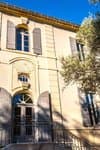
LE PARADOU - The Castillon Towers
The Castillon Towers enables you to travel between eras. From the creation of the Alpilles massive 125 million years ago to its appropriation by man today, this walk is a real travel through time. In the small mountain range of Pène, men have found it to be a refuge since the Iron Age to the point to stay there over the centuries. Now owner of fauna and flora, it is possible to know from the top of this small hilly area, the evolution of this site and its surroundings.
10 points of interest
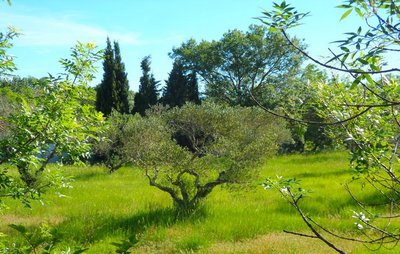
Un olivier aux multiples troncs - ©Jason Gaydier - PNR Alpilles  Produits du terroir
Produits du terroirThe territory's symbol
The olive tree is an iconic culture of the territory and is the symbol of the dry Mediterranean climate. Its multiple trunks are the result of a grafting near the stump following a long lasting frost in 1956. Today, olives and oils produced in the Alpilles are products recognized nationally and internationally, benefiting from the Appelation d'Origine Protégée - AOP (European quality logo attesting regional origin), which marks its uniqueness.
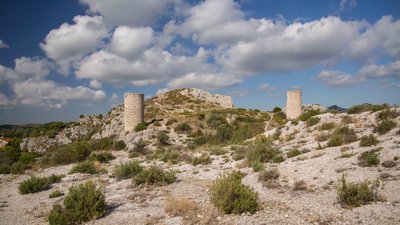
Les tours, reliées par un rempart, protégeaient une agglomération d'une quarantaine de foyers - ©Orlane Fougeroux  Patrimony and history
Patrimony and historyThe Castillon Towers
Occupied for the first time since the Iron Age, the Castillon site grew considerably in the 11th century, when the Lords of Baux made it a strategic location for the defence of their territory and a surveillance station of the communication routes. The castle, now gone, had four towers at the time. The site that you are discovering only has three today.
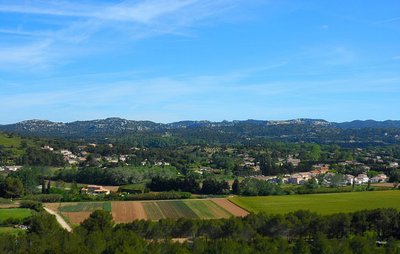
Vue sur le massif des Alpilles - ©Jason Gaydier - PNR Alpilles  Peak
PeakAn island in the middle of the plains
The Chaîne des Alpilles stretches over 30km, culminating at 498m at the top of the Opies. At the whim of peaks, cliffs, valleys and foothills, this very Mediterranean limestone massif is home to remarkable environments. The Alpilles are composed of emaciated soils of which the white limestone was formed 125 million years ago by the accumulation of microorganisms in the ocean which covered it here. It was the collision of the African and European tectonic plates that created these mountainous areas.
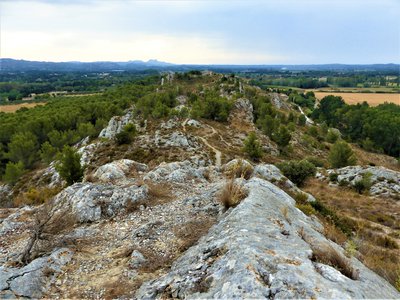
Les rochers de la Pène - ©Rémi Sérange - PNR Alpilles  Geology
GeologyRocks of Pène
The rocks of the Pène, which shelter the Castillon Towers, belong to the narrow chain of "Hills" extending for 15 km from west to east, in the Alpilles massif. Traveling Fontvieille, Paradou, Maussane-les-Alpilles and Mouriès, it ends at the Caisses de Jean-Jean. The rocks of the Pène peak at 58 meters altitude south of Paradou. They have a marked southward slope and consist of calcareous beds of the Upper Cretaceous.
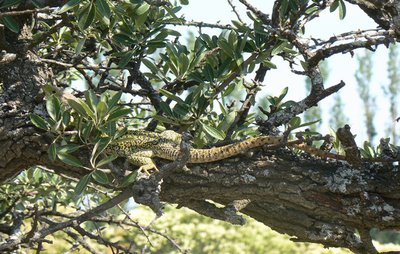
Lézard ocellé perché sur une branche d'arbre - ©Nicolas Sadaillan - Mairie de Sénas  Fauna
FaunaThe spotted dragon of the Alpilles
Ranging from 60 to 90cm long, the Ocellated Lizard (Jewelled Lacerta) is the largest of its kind. This lizard enjoys dry, sunny places such as olive groves or unoccupied rocky areas. It is essentially characterized by its few blue spots along its flanks. Its diet consists of fruits as well as small mammals, through other insects. It is protected and the person that even manages to catch it will be fined.
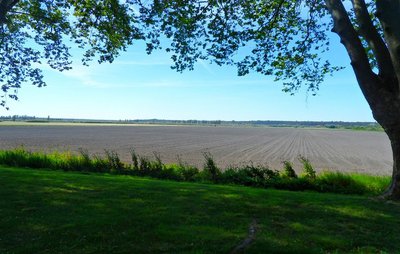
Marais asséché - ©Jason Gaydier - PNR Alpilles  Savoir-faire
Savoir-faireThe draining of the swamps
The depression between the Rochers de la Pène and the Crau plain far off gets runoff water from the Alpilles and rising groundwater tables. This bowl effect creates the natural conditions of the swamp of Baux, a phenomenon reinforced by low altitude (-1 to 2m). The gradual draining of the marshes was conducted to diversify crops, thereby producing the Crau hay, wheat and other cereals. Today there is only a small marsh area to the west.
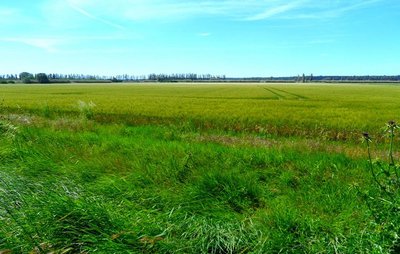
Champ de foin de Crau - ©Jason Gaydier - PNR Alpilles  Produits du terroir
Produits du terroirAn exceptional hay
An Appellation d'Origine Contrôlée (European label for quality guarantee) since 1997, the hay of Crau is the only animal food with that label. Its production began with the first irrigation canals built under the supervision of Adam de Craponne. Its production follows five steps: watering, cutting, turning (hay drying), gathering in windrows (lining up the racked hay to facilitate harvesting) and finally storing. It is renowned worldwide, and Arab princes have it imported to feed their animals.

Entrée du mas de Castillon - ©Jason Gaydier - PNR Alpilles  Patrimony and history
Patrimony and historyThe Provençal farmhouse, called Mas
South of the Pene massif, the road skirts the Mas of St-Jean, of Castillon, of Baraquet as well as the Mas du Pas de Loche. They are testimony to the establishment of agricultural systems of the 18th century. The openings are reduced to the northeast for protection against the Mistral. Annexes were built gradually according to the family's needs and cultivation requirements. The climbing vine, the well and the plane trees hedges complete the image of the farmhouse.
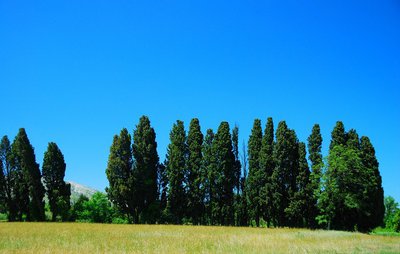
Haies de cyprès - ©PNR Alpilles  Flora
FloraThe role of hedges
Many hedges segment the territory and separate the various areas. From cedar or cypress, these hedges have the primary function to partially protect the various crops from the wind and frost. Other action, they help to create corridors of favourable winds for the circulation of bat species. Finally, these trees are known for their wood, very strong, fragrant, and have served to form the framework of many farmhouses in the Alpilles.
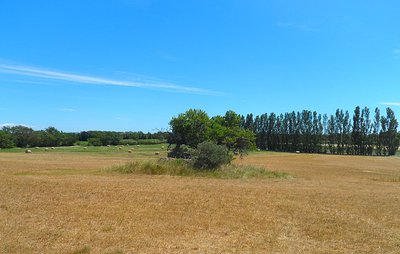
Les ruines de la cabane du berger - ©Jason Gaydier - PNR Alpilles  Elevage et pastoralisme
Elevage et pastoralismeThe pastoralism remains
The Alpilles are grounds for farming and pastoralism. Extensive cattle, goat or sheep grazing guarantees a plant biodiversity preventing the overrunning and the closing of the environment, contributing at the same time to the fight against fire. Here, herds and flocks are fond of Castillon grasslands or the marsh, as evidenced by this former shepherd's hut, now collapsed. The latter has similar features as the borie.
Description
At the car park, take the rocky path marked in blue which goes up a gentle slope, going along an organic olive grove on the left.
1 – Once the towers in sight, take the track which rises on the right, leaving the first turn on the left behind. When reaching the third tower, which was hidden until now, turn right then continue following the blue marked trail by going along the rocks of Pène.
2 – At the road, turn immediately left and follow it along the path of Castillon towards different Mas (Provençal farmhouses). Possible presence of cars. Continue on the road until the junction at the Saint-Jean bridge.
3 – Arriving at the "RIS" sign, turn left to take back the path that sinks again into the little massive.
1 – Back to the Castillon towers, turn right and follow the first path taken to complete the tour of the towers.
- Departure : Car park of the "Tours de Castillon", in Paradou
- Arrival : Car park of the "Tours de Castillon", in Paradou
- Towns crossed : Paradou
Forecast
Altimetric profile
Recommandations
Do not go into the towers, risk of collapse.
Caution with your ankles on the trails of the rocks of Pènes (between point 1 & 2 and between points 3 & 1).
Respect the tranquillity of the place: The Mas (Provençal farmhouses) are private property.
Watch out for cars on the roadside.
Information desks
House of the Alpilles Regional Nature Park
2, boulevard Marceau, 13210 Saint-Rémy-de-Provence
Located in the heart of the city centre of Saint-Rémy-de-Provence, the House of the Alpilles Nature Park welcomes you to its completely renovated premises. This new vibrant place is multifunctional: it accommodates the Park's engineering team but also has a public reception space and showrooms. A true resource centre of the Park's heritage, it aims to support and promote locals, visitors and tourists on all 16 municipalities of the Park.
Open Monday to Friday, from 9 am at 12:30 pm and from 1:30 pm to 5 pm.
Free admission.
OTI Alpilles-en-Provence
Place Jean Jaurès, 13210 Saint-Rémy-de-Provence
Access and parking
In Paradou, follow the D78d towards Saint-Martin-de-Crau to exit the village. Turn right before the Saint-Jean bridge when heading to the car park.
Parking :
Access
- Emergency number :
- 114
Report a problem or an error
If you have found an error on this page or if you have noticed any problems during your hike, please report them to us here:

